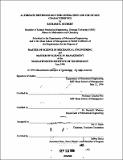Alternate methodology for generation and use of key characteristics
Author(s)
Seubert, Richard E. (Richard Eugene)
DownloadFull printable version (5.838Mb)
Other Contributors
Sloan School of Management.
Advisor
Charles Fine, Anna Thornton and Daniel E. Whitney.
Terms of use
Metadata
Show full item recordAbstract
Hardware variation reduction is an issue of paramount importance to manufacturing companies in their efforts to reduce cycle time and manufacturing costs. Hardware variation leads to increased rework, and decreased levels of customer satisfaction. The Boeing Company, the leading manufacturer of commercial jet aircraft, in the late 1980's and early 1990's introduced two separate programs to address hardware variation. Advanced Quality Systems (AQS) addressed variation in components from suppliers; Hardware Variability Control (HVC) addressed hardware variation internal to Boeing. One of the tools utilized by both AQS and HVC is the use of Key Characteristics. Key Characteristics are defined at Boeing as "Attributes or features of a material, part, assembly, installation or system in which variation from nominal has the most adverse affect upon fit, performance, or service life." Key characteristics are generated by first identifying the features or requirements of the end product which are of primary importance to the customer. These requirements are then "flowed down" through the different layers of the engineering tree and build plan to determine those attributes or features at the assembly, subassembly, or detail part level which play a critical role in delivering the product level customer requirements. This methodology therefore allows Boeing to focus on those elements of the manufacturing process where hardware variation has the most potential for causing a quality loss in customer satisfaction. Recently a new methodology has been developed at The Massachusetts Institute of Technology. This methodology, named herein as the quad key methodology, expands the classifications for key characteristics to include the designations of product key characteristics, assembly key characteristics, manufacturing key characteristics, and Stat key characteristics. This new methodology was applied to the analysis of the lower gate assembly for the forward entry door for the new 737-X model airplane, currently in the product design stage at Boeing. The research showed that the added designations for keys available under the quadkey methodology offered several advantages over that included under HVC. Additional uses for key characteristics are also discussed outside of their application for the reduction of hardware variation.
Description
Thesis (S.M.)--Massachusetts Institute of Technology, Dept. of Mechanical Engineering; and (S.M.)--Massachusetts Institute of Technology, Sloan School of Management, 1996. Includes bibliographical references (p. 96).
Date issued
1996Department
Massachusetts Institute of Technology. Department of Mechanical Engineering; Sloan School of ManagementPublisher
Massachusetts Institute of Technology
Keywords
Mechanical Engineering., Sloan School of Management.